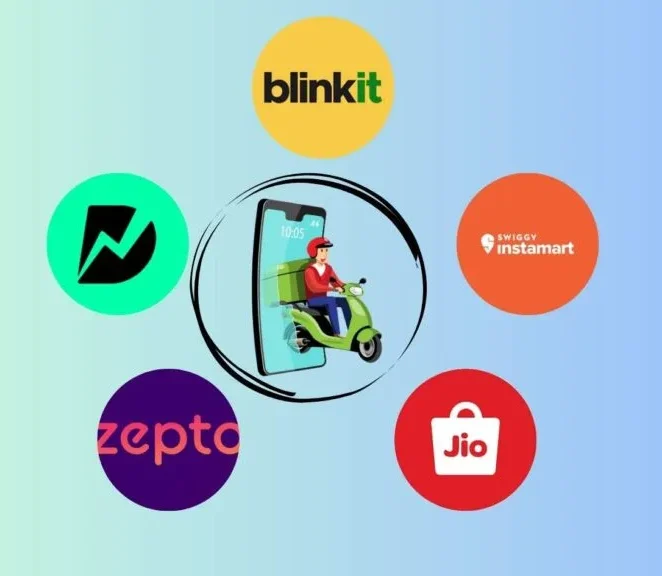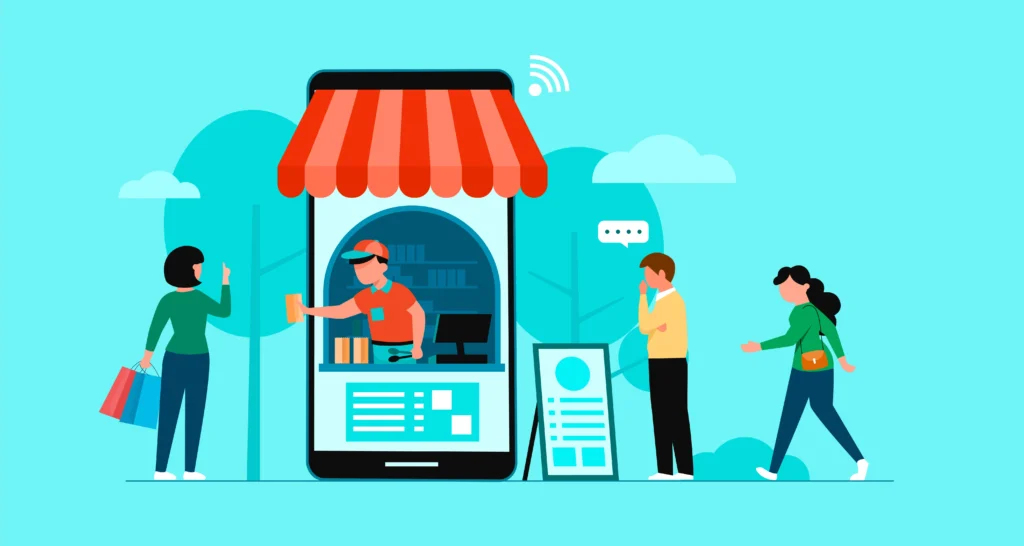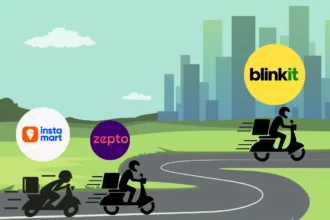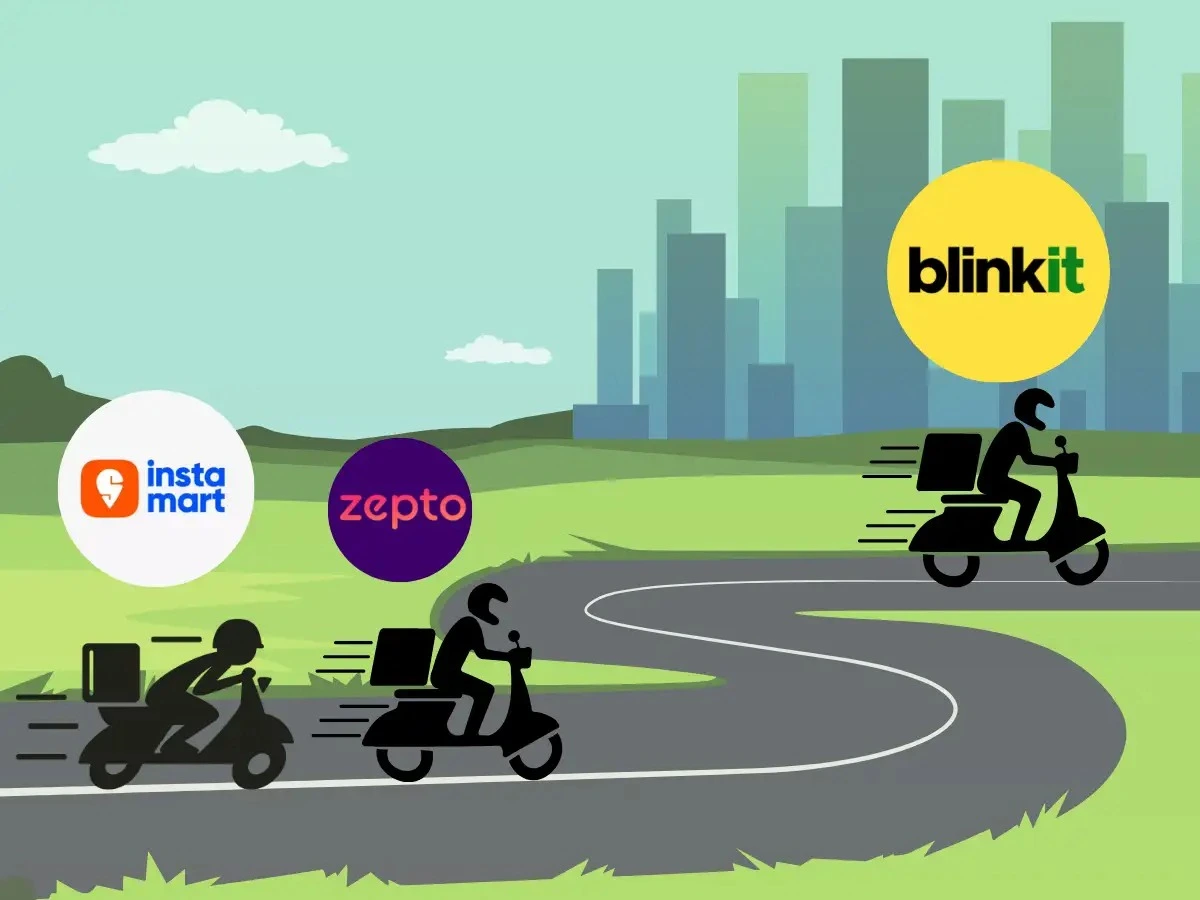Estimated Reading Time: 22-26 minutes (4,554 words)
Introduction
Quick commerce (q-commerce) represents the next evolutionary leap in retail: a model where groceries, snacks, personal care products, stationery, and even emergency medicines are delivered not in hours, but within 10–30 minutes. In fast-paced urban environments—especially across Tier-1 Indian cities—consumers no longer plan weekly shopping trips; they expect instant fulfilment. This shift is driven by rising dual-income households, unpredictable work schedules, and the growing preference for convenience over price. The core value proposition is effortless: get exactly what you need, exactly when you need it, without leaving home.
Behind the scenes, q-commerce relies on a sophisticated operational backbone: dense networks of micro-warehouses (dark stores), AI-driven demand forecasting, and real-time inventory visibility. Platforms like Blinkit, Zepto, and Swiggy Instamart use algorithmic batching, optimized rider routing, and SKU-curated assortments to minimize delays and maintain profitability. This infrastructure enables platforms to balance speed with margin efficiency—something traditional supermarkets and e-commerce players struggle to achieve. As a result, q-commerce isn’t just a logistics innovation; it’s a supply-chain revolution reshaping how products move within cities.
The rise of q-commerce is also transforming the business economics of retail. High-frequency purchases bring higher lifetime value (LTV), allowing companies to unlock new monetization layers such as in-app advertising, private labels, bundling strategies, and increased average order value (AOV) through curated recommendations. With India projected to add millions of new digital-first consumers by 2030, quick commerce is emerging as one of the most competitive and lucrative sectors—blurring lines between grocery delivery, e-commerce, and hyperlocal retail. The result is a category that is no longer a “convenience premium,” but a mainstream consumer habit poised to shape the next decade of urban consumption.

Quick Facts & Market Snapshot (2024–2025)
Global Market Overview
- According to a report by The Business Research Company, the global quick commerce (q-commerce) market was valued at US$ 104.1 billion in 2024, and is expected to reach US$ 129.7 billion in 2025, reflecting very strong growth. The Business Research Company+1
- Other sources, like Fortune Business Insights, estimate an even larger base — US$ 170.8 billion in 2024, growing to US$ 184.6 billion in 2025. Fortune Business Insights
- On the demand front, Statista projects that q-commerce revenue will hit US$ 198.1 billion in 2025, and estimates a 2025–2030 CAGR of ~7.7%, with the user base growing to nearly 933 million users by 2030. Statista
- The variation in these estimates (104B vs ~171B) reflects different market-definition scopes, but all signals point to rapid scale-up of q-commerce globally.
India Market Snapshot
- In India, quick commerce is not just growing — it is dominating the e-grocery segment. A joint report by Bain & Company and Flipkart showed that in 2024, over two-thirds of all e-grocery orders came via q-commerce platforms. ETRetail.com+1
- The same report estimates the GOV (gross order value) of Indian quick commerce to be US$ 6–7 billion in 2024, up from roughly US$ 1.6 billion in 2022. Moneycontrol
- Q-commerce also accounted for about one-tenth of overall e-retail spending in India in 2024. The Times of India
- According to Bain, the q-commerce market in India is projected to grow at a 40%+ annual rate through 2030, driven by category expansion (beyond groceries), geographic depth, and increased customer adoption. preprodcms.bain.com
Recent Funding Highlights
- Zepto, one of India’s fastest q-commerce startups, raised US$ 450 million in a recent funding round (October 2025), pushing its valuation to US$ 7 billion — a strong vote of investor confidence in the category. TechCrunch+1
- According to Zepto’s CEO, much of this capital will fuel expansion of dark stores and strengthen operations as the company scales in multiple Indian cities. TechCrunch
Platform Growth & Execution Metrics
- Swiggy Instamart, another major q-commerce player, reported 101% YoY growth in GoV (gross order value) in Q4 FY 2025, reaching ₹ 4,670 crore (≈ US$ 560–580 million). The Economic Times+1
- In the same quarter, Instamart added 316 new dark stores — more than its total additions over the prior eight quarters — and expanded its service to 124 cities. The Economic Times
- Their average order value (AOV) also increased, from previous levels to about ₹ 527, indicating that customers are not just transacting more, but buying more per order. The Economic Times
- Swiggy’s Q4 FY25 results further confirm this push: in its annual report, it noted that its quick commerce business added 498 net new dark stores, nearly doubling its active dark-store area to ~4 million sq ft. Swiggy
Key Takeaway & Strategic Implication
- The q-commerce market is both large and accelerating globally. But the very scale comes with high capital intensity: dark stores, inventory, last-mile costs.
- In India, quick commerce is no longer a niche — it’s become central to e-grocery, capturing two-thirds of orders. But profitability remains a question.
- For platforms and investors, the core tension is growth vs economics: sustained growth is attracting capital, but long-term success depends on improving unit economics (higher AOVs, denser dark-store networks, monetization via ads/subscriptions).
How Q-Commerce Works: Dark Stores, Last Mile & Technology
Dark Stores / Micro-Fulfilment Centres (MFCs)
Quick commerce is built on a dense network of micro-fulfilment centres (MFCs) — compact warehouses typically ranging between 500 sq. ft. to 2,500 sq. ft. These facilities are strategically placed within high-density neighbourhoods to ensure that 80–90% of customer orders fall within a 2–3 km radius. Unlike traditional supermarkets, dark stores are not open to walk-in customers, allowing them to optimize every inch for speed: narrow aisles, SKU-grouped shelving, pick-to-light systems, and dedicated packing stations.
Many q-commerce players also operate tiered MFCs: small 500–800 sq ft hubs in premium zones for ultra-fast 10–15 min deliveries, and larger 2,000+ sq ft centres for high-volume areas. This hybrid network helps balance speed, inventory depth, and cost-efficiency while reducing stockouts during peak hours.
Inventory & Assortment Strategy
Unlike supermarkets that stock 20,000–40,000+ SKUs, q-commerce platforms typically offer a curated assortment of 3,000–10,000 SKUs. This SKU strategy focuses on:
- High-turnover FMCG (milk, bread, eggs, packaged snacks)
- Daily essentials (rice, oil, sugar, cleaning supplies)
- Fresh & perishables (produce, ready-to-cook, bakery items)
- Impulse categories (ice creams, chocolates, beverages)
- Ready-to-eat quick meals, frozen foods
- Private labels, which have higher margins and faster rotation
AI-driven demand forecasting analyzes local ordering patterns (e.g., morning milk peaks, weekend snack spikes) to adjust inventory and reduce wastage. Many leading platforms now operate temperature-zoned storage — chilled, frozen, and ambient — enabling category expansion into meats, dairy, and beverages without compromising freshness.
Last-Mile Delivery: Fleet & Zone Optimization
Last-mile delivery is the most cost-sensitive part of q-commerce. To hit sub-30-minute SLAs, platforms rely on gig-based riders using bikes or electric scooters, each operating within micro-zones designed to minimize distance and traffic friction.
Delivery routing takes into account:
- real-time traffic conditions
- rider proximity
- batch-able orders
- weather disruptions
- store pick & pack time
- customer priority (subscriptions vs regular users)
Most q-commerce networks aim for delivery zones of 1.5–3 km, optimizing for speed rather than coverage. Riders often pick up orders in under 2 minutes, supported by ready-bagged packets or pick-up lanes. Increasingly, companies are piloting EV fleets, promising lower cost per delivery and higher sustainability.
The Tech Stack: AI, Automation & Real-Time Systems
Behind the consumer-facing “10–20 minute delivery” promise lies a complex technology ecosystem. The q-commerce tech stack typically includes:
- Real-time stock sync across all dark stores
- Predictive replenishment using AI-demand forecasting
- Automated batching (multiple orders routed to one rider)
- Dynamic slot pricing for high-demand time windows
- Route optimization via GPS + traffic feeds
- Order ETA prediction engines
- Heat-map based store-level demand planning
- Shelf-level analytics to optimize SKU placement
Newer innovations include computer-vision-enabled product scanning, RFID-based fast-pick systems, and predictive weather-triggered demand models (e.g., cold drinks spike in heat waves).
Monetization Modules & Revenue Streams
While delivery fees are visible to users, most q-commerce monetization comes from layered revenue streams such as:
- Delivery fees & surge pricing: Often fluctuating by time, demand, and basket size.
- Subscription passes (Blinkit Gold, Zepto Pass): Offering free delivery, priority ETAs, and exclusive discounts — boosting customer stickiness.
- CPG brand partnerships: FMCG companies pay for promoted placements, homepage banners, and search boost listings.
- In-app advertising: A fast-growing revenue line; q-commerce apps now function like retail media platforms.
- Private labels: Higher-margin proprietary brands in snacks, bakery, dairy, home essentials.
- Bundled deals & higher AOV categories: Example — gifting, electronics accessories, personal care kits.
- Dynamic pricing & SKU upselling: AI-led substitute recommendations when items go out of stock.
These monetization levers improve unit economics, helping platforms offset thin margins in last-mile logistics.
Company Deep Dives: Blinkit, Zepto & Swiggy Instamart
Blinkit (Part of Zomato / Eternal)
History & Positioning
Blinkit began in 2013 as Grofers, one of India’s earliest online grocery platforms. After shifting from a marketplace to an inventory-led model, it pivoted sharply into 10–20 minute quick commerce in 2021. In 2022, Zomato acquired Blinkit in an all-stock deal valued at ₹4,447 crore, positioning it as Zomato’s long-term bet on groceries and essentials.
By 2025, Zomato rebranded to Eternal, bringing Blinkit, Hyperpure, and Zomato’s core delivery business under a unified ecosystem. The rebrand represented Zomato/Eternal’s strategy to build a multi-vertical commerce “super-app”. Blinkit became the flagship q-commerce vertical, central to Eternal’s growth and monetization roadmap. (Source: Mint)
Strategic Strengths
- Massive shared user base: Blinkit benefits from Zomato/Eternal’s food delivery customers, enabling seamless cross-selling.
- Integrated loyalty programs: Blinkit Gold + Zomato Gold synergy drives retention and higher frequency.
- Brand partnerships: Strong bargaining power with FMCG brands for promotions, in-app ads, and exclusive launches.
- Operational depth: Zomato’s logistics algorithms, payments stack, and customer-side data enhance Blinkit’s efficiency.
- Category expansion: Leading the shift from groceries to higher AOV products (gifting, electronics accessories, appliances).
Challenges
- Profitability pressure: Blinkit is expanding geographically and in categories, putting strain on unit economics.
- Integration complexity: Merging dark stores, tech stacks, and team structures with Eternal’s ecosystem requires high coordination.
- High capex footprint: Rapid dark-store expansion increases operational costs before revenue catches up.
- Competitive pressure: Zepto’s speed-focused model and Instamart’s rider density force Blinkit to keep prices tight.
Outlook
Blinkit is positioned as Eternal’s highest-growth vertical. Expansion into new categories (beauty, electronics, home improvement) and high-margin ads/private labels may help unlock profitability by 2026–27.

Zepto
History & Positioning
Founded in 2021 by 19-year-old Stanford dropouts (Aadit Palicha & Kaivalya Vohra), Zepto quickly became the poster child of India’s quick commerce revolution. It gained traction with its ‘10-minute delivery guarantee’ and laser focus on dark-store operations.
By 2025, Zepto raised a major $450M funding round and hit a $7B valuation, among the highest in India’s consumer-tech ecosystem. The new capital has been channelled into aggressive dark-store expansion, tech infrastructure, and category diversification. (Source: TechCrunch)
The company has also begun exploring IPO readiness — tightening unit economics and building governance structures.
Strategic Strengths
- Speed-focused DNA: Zepto’s dark stores are meticulously optimized for <15-minute deliveries.
- Advanced experimentation stack: Heavy use of A/B testing, micro-fulfilment analytics, SKU clustering, and run-rate prediction.
- Founder-led agility: Ability to pivot quickly across assortment, pricing, and hyperlocal layouts.
- Funding-backed expansion: Capital infusion supports strategic city launches and deeper metro penetration.
- Younger audience pull: Strong adoption among Gen Z and high-income millennial consumers.
Challenges
- Unit economics outside metros: Smaller or less dense cities cannot match the order velocity needed for profitability.
- High burn model: Speed and store density come at high capex + opex.
- Limited ecosystem leverage: Unlike Blinkit/Instamart, Zepto lacks a parallel food-delivery business for cross-selling.
- Brand recognition gap: Though improving, it still trails Zomato and Swiggy in mass-market recall.
Outlook
With fresh funding and a strong tech backbone, Zepto is expected to prioritize:
- deeper category margins (private label grocery, bakery, home essentials)
- mid-size tier-1 expansion
- operational automation (computer vision, demand forecasting)
Zepto is widely seen as the dark horse with potential to become profitable faster due to operational discipline.
Swiggy Instamart
History & Positioning
Swiggy launched Instamart in 2020, initially through partnerships before shifting to fully inventory-led dark stores. Leveraging Swiggy’s enormous hyperlocal delivery network, Instamart quickly scaled into one of India’s top three q-commerce players.
By 2024–25, Instamart posted triple-digit YoY GOV growth, added hundreds of dark stores, and expanded service to over 120 cities, becoming a major revenue pillar for Swiggy. (Source: The Economic Times)
Strategic Strengths
- Shared delivery fleet: Swiggy’s large rider base reduces cost per delivery and ensures strong citywide density.
- Cross-sell power: Food delivery + grocery combo boosts frequency and basket size.
- Brand collaborations: Strong FMCG ties, exclusive SKUs, and partnerships for sampling / launches.
- Rapid fulfilment improvements: Instamart has optimized pick-pack times and routing algorithms for speed and consistency.
- Geo-expansion capability: Strong presence in Tier-1 and Tier-2 markets leveraging Swiggy’s wider footprint.
Challenges
- High operating losses: Faster expansion = higher burn; Instamart’s losses have been rising as it scales.
- Competition for real estate: Prime dark-store locations are expensive and limited in top cities.
- Rider management complexity: Balancing food delivery and grocery needs within one fleet is operationally challenging.
- Margin pressure: Grocery margins are lower than restaurant commissions, adding strain to profitability.
Outlook
Instamart is positioned to grow aggressively in the next phase, especially with:
- deeper category penetration in snacks/beverages, home categories, beauty
- stronger retail media monetization
expansion into gifting, express medicine delivery, and premium groceries
Swiggy’s upcoming IPO (delayed but expected) may also bring sharper focus on Instamart’s profitability metrics.
Unit economics: challenges & path to profitability
Q-commerce has a classic two-sided economic issue:
- Revenue per order is low (typical AOV ~₹400–₹600 in India). Even with scale, AOV growth is slow — for example, Swiggy once reported Instamart’s AOV rising to ~₹527, showing the structural challenge of small, high-frequency baskets.
- Fulfilment costs are high per order: every order requires picking, packing, QC, and ultra-fast last-mile delivery, all supported by high fixed costs (dark store rent, refrigeration, staff, tech infra, rider incentives).
- Subsidies & promotions drive early adoption but significantly compress contribution margins. Heavy reliance on discounts keeps customer acquisition high but delays break-even at the order level.
Paths to better economics:
- Raise AOV with bundles, value packs, add-ons, private labels, ready meals, and cross-category selling (beauty, pet care, pharma, and alcohol where permitted).
- Subscription passes (free delivery, priority windows, rewards) to smooth out delivery margins and boost repeat purchases.
- Ad & retail media revenue from CPG brands: sponsored listings, search ads, homepage banners, and seasonal campaigns help offset fulfilment costs.
- Dark-store density & optimization: concentrating orders within tight radii, improving batching, reducing idle time, and increasing repeat orders per pin code.
- New revenue lines such as B2B analytics, data insights for brands, and private-label expansion — all highlighted by analysts as crucial for long-term viability.
Consumer behavior & category expansion
- Urban consumers initially relied on q-commerce for top-ups and emergency products — milk, bread, eggs, soft drinks, sanitary pads, OTC meds, and last-minute cooking ingredients. Over time, usage has shifted from “urgent replacements” to planned convenience, with many households now buying daily staples, fresh produce, meat, bakery, and even weekly groceries through q-commerce apps.
- The category mix is diversifying: platforms are pushing ready-to-eat (RTE), ready-to-cook (RTC) kits, fresh fruits/veggies, frozen snacks, pet food, gifting, electronics accessories, and beauty products. Meal kits, bakery specials, festive SKUs, and private-label essentials are becoming fast-growing segments as platforms try to raise AOV and increase weekly order frequency.
- Adoption remains strongest in Tier-1 metros (Delhi NCR, Mumbai, Bengaluru, Hyderabad, Chennai) and rapidly growing Tier-2 cities (Pune, Ahmedabad, Jaipur, Lucknow, Kochi). However, scaling into Tier-3+ towns faces challenges: lower population density, smaller basket sizes, higher cost-to-serve, limited dark-store real estate, and fewer high-frequency use cases. This makes unit economics tougher outside dense urban clusters, as highlighted by multiple retail and logistics analyses.
Risks, regulation & competitive landscape
- Regulatory risks:
- Evolving labour policies for gig workers — including mandatory social security contributions, minimum earnings floors, insurance, and working-hour guidelines — could materially increase delivery costs for q-commerce platforms.
- City-level zoning rules are becoming stricter as municipalities evaluate complaints about dark stores operating like retail outlets in residential areas. Several cities have already begun discussing location permits, operating-hour limits, and compliance standards for micro-fulfilment centers.
- Additional friction may arise from local GST interpretations, municipal delivery fees, or new digital commerce guidelines, all of which can impact margins.
- Evolving labour policies for gig workers — including mandatory social security contributions, minimum earnings floors, insurance, and working-hour guidelines — could materially increase delivery costs for q-commerce platforms.
- Competitive intensity:
- Large incumbents like Amazon, Flipkart, Reliance Retail (JioMart) and BigBasket continue to experiment with 2-hour express delivery, deep discounting, faster last-mile logistics, and hyperlocal distribution.
- Regional grocery chains and emerging startups may also enter the space through franchise-based dark store networks, pressuring prices and customer acquisition costs.
- With categories like meat, bakery, beauty, and fresh produce becoming high-margin battlegrounds, platforms must differentiate via assortment depth, delivery reliability, private-label brands, and loyalty programs.
- Large incumbents like Amazon, Flipkart, Reliance Retail (JioMart) and BigBasket continue to experiment with 2-hour express delivery, deep discounting, faster last-mile logistics, and hyperlocal distribution.
- Capital market dependence:
- Q-commerce remains a capital-intensive business, heavily reliant on external funding to cover early-stage burn, dark-store rollouts, and customer subsidies.
- The availability of capital typically decides which companies can sustain price wars; Zepto’s $450M fundraise and $7B valuation in 2025 demonstrated that investors are still willing to back category leaders with scale potential.
- However, smaller or regional players without deep funding may struggle to survive if unit economics tighten, interest rates rise, or capital markets become more conservative.
- Q-commerce remains a capital-intensive business, heavily reliant on external funding to cover early-stage burn, dark-store rollouts, and customer subsidies.
10-year outlook (2025 → 2035)
- 2025–2030: Consolidation, stabilisation, and platform maturity
- The second half of the 2020s will likely see heavy consolidation, with only 2–3 national leaders in each major market (India included). As competition cools, platforms will rationalize loss-making stores and focus on high-density clusters, turning dark stores into predictable, data-driven fulfilment assets rather than growth burn centers.
- Dark-store networks could expand from hundreds to thousands of micro-fulfilment centers, especially across Tier-1 and dense Tier-2 cities. Optimized layouts, automation tools (pick-to-light, conveyor-assisted picking), and more accurate demand forecasting will improve efficiency.
- Advertising and brand partnerships (CPG ads, promoted listings, in-app search placements, sampling campaigns, first-party data analytics) will become a major revenue line, similar to Amazon Ads. For some platforms, ad revenue may surpass delivery margins.
- India’s q-commerce GMV, currently in the single-digit billions (mid-2020s), could grow 3–5× by 2030, powered by rising urbanization, dual-income households, smartphone penetration, and consumer preference for “instant purchasing” over weekly stock-ups.
- The second half of the 2020s will likely see heavy consolidation, with only 2–3 national leaders in each major market (India included). As competition cools, platforms will rationalize loss-making stores and focus on high-density clusters, turning dark stores into predictable, data-driven fulfilment assets rather than growth burn centers.
- 2030–2035: Q-commerce becomes infrastructure, not a novelty
- By the early-to-mid 2030s, q-commerce will be embedded into daily urban life, functioning as a “fourth utility” after electricity, broadband, and UPI — a default convenience layer for groceries, pharmacy, fresh food, gifting, and impulse purchases.
- Unit economics will improve through automation, predictive inventory, vertical integration, and greater private-label penetration (food staples, personal care, snacking, ready meals), allowing platforms to capture better margins.
- Business models will resemble a retail + logistics + media hybrid, where the economics of q-commerce rely not just on product sales but on ad impressions, brand bidding, sampling fees, logistics-as-a-service, and AI-driven merchandising.
- Expansion into rural and low-density areas will remain selective due to low order density, unless breakthroughs like drone delivery corridors, autonomous vehicles, or hyperlocal franchise-owned micro-warehouses substantially reduce last-mile costs.
- By 2035, q-commerce may converge with AI-driven smart homes — with predictive replenishment (auto-ordering milk, fruits, cleaning supplies) becoming mainstream.
- By the early-to-mid 2030s, q-commerce will be embedded into daily urban life, functioning as a “fourth utility” after electricity, broadband, and UPI — a default convenience layer for groceries, pharmacy, fresh food, gifting, and impulse purchases.
FAQs Section
1. What is quick commerce (q-commerce)?
Quick commerce (q-commerce) is a hyperlocal delivery model that enables consumers to receive groceries, household essentials, snacks, personal care items, and OTC health products within 10–60 minutes.
It relies on:
- Dark stores (micro-warehouses) located inside neighborhoods
- Optimized inventory layouts for picking items in under 90 seconds
- AI-driven routing systems to reduce rider travel distance
- High-order density within a 2–3 km radius
Q-commerce is now a distinct category within e-commerce, designed for impulse purchases, emergency needs, and convenience-led shopping.
2. Which q-commerce apps work in India?
India is one of the fastest-growing q-commerce markets globally. Major players include:
- Blinkit (Zomato/Eternal Group) – strongest assortment depth, heavy on convenience categories
- Zepto – known for the “10-minute delivery” playbook and aggressive expansion
- Swiggy Instamart – built on Swiggy’s delivery fleet and large user base
- JioMart Express – hyperlocal pilot programs backed by Reliance Retail
- BigBasket BB Now – express grocery through Tata-owned BigBasket
- Amazon Fresh (express slots) – hybrid model with shorter delivery windows
Region-specific players also exist in cities like Bengaluru, Hyderabad, and Mumbai.
3. Is q-commerce profitable?
Most q-commerce players are not yet profitable at national scale, because:
- Dark store leases, utilities, and staffing are expensive
- Riders require incentives for peak-hour or rainy-day delivery
- High customer discounts and promo-led acquisitions increase burn
- Per-order margins are low due to affordable grocery pricing
However, profitability is improving as platforms shift from pure delivery businesses to hybrid retail + advertising ecosystems.
Profitability levers:
- Larger AOVs → higher margins
- Private-label brands → 25–40% margin
- In-app advertising → near 80–90% margin
- Logistics automation → fewer pickers per store
- Dark-store utilization → more orders per sq. ft.
Analysts expect market leaders to hit profitability between 2026–2029 depending on the pace of consolidation.
4. What’s the average order value (AOV) in India?
The typical q-commerce order in India ranges from ₹400–₹600, driven by fast-moving FMCG and snacks categories.
Examples:
- Blinkit: AOV often ranges around ₹450–₹550
- Instamart: Swiggy publicly reported an AOV of ~₹527
- Zepto: Strong AOV in dense metros due to frequent purchases by young professionals
AOV is rising due to:
- Larger grocery baskets
- Addition of beauty, pet care, gifting, bakery, and electronics accessories
- Surge ordering during festivals and late-night hours
A higher AOV directly improves contribution margin per order.
5. How do q-commerce apps make money?
Q-commerce companies use a multi-revenue model, similar to food delivery + retail + digital advertising.
Major revenue streams include:
Primary Revenue
- Delivery fees + dynamic surge pricing
- Margin from product sales
- Commissions from FMCG/D2C brands
- Subscription plans (e.g., Zomato Gold, Swiggy One, Zepto Pass)
High-Margin Revenue
- In-app advertising inventory
- Banner ads
- Sponsored listings
- Category takeovers
- Sampling campaigns
- Banner ads
- Brand-funded promotions
- Sponsored product placement inside search results
Future Revenue Lines
- Private-label products
- Last-minute medicines
- Meal kits + ready-to-eat food
- B2B restaurant supply (in pilot at some platforms)
Advertising alone is projected to form 15–25% of revenue for leading platforms by 2030.
6. Are dark stores legal?
Yes, dark stores are legal commercial properties, but they must comply with:
- Fire safety protocols
- FSSAI (for food storage)
- Municipal trading licenses
- Zoning regulations (commercial vs. mixed-use vs. residential)
- Noise and traffic control rules
Some cities have expressed concerns over traffic at odd hours, resulting in temporary closures or stricter zoning guidelines. Operators increasingly use basement warehouses, industrial spaces, or shared micro-fulfilment hubs to stay compliant.
7. How do q-commerce apps compete with local kirana stores?
Q-commerce competes on:
- Delivery speed (10–60 mins vs 2–4 hours for kiranas)
- More SKUs (3,000–10,000 items vs 500–1,500 in kiranas)
- Consistent quality
- Cashless convenience
Kirana stores counter by:
- Joining ONDC, Udaan, Jumbotail, or Dukaan Online
- Providing WhatsApp ordering with free delivery
- Stocking more ready-to-eat and premium SKUs
- Leveraging neighbourhood relationships
In many cities, kiranas now complement rather than compete with q-commerce.
8. Is q-commerce available outside metros?
Yes, but adoption varies:
High Penetration
- Tier-1 metros (Delhi, Mumbai, Bengaluru, Hyderabad, Chennai)
- Tier-2 cities (Pune, Ahmedabad, Jaipur, Kochi, Chandigarh, Lucknow)
Medium Penetration
- Tier-3 cities with high student or IT-worker density
- Towns with good road infrastructure and strong middle class
Low Penetration
- Rural and low-density areas where:
- Order frequency is low
- Rider distances are long
- AOV is small
- Dark stores are harder to operate profitably
- Order frequency is low
Expansion outside Tier-1/2 is expected only after tech-enabled cost reductions (autonomous vehicles, improved routing, robotic pickers).
9. Which sectors can benefit from q-commerce?
Industries gaining the most from q-commerce include:
- FMCG (snacks, beverages, dairy, personal care)
- D2C brands (beauty, wellness, home essentials)
- Pharma & personal wellness (OTC medicines, health supplements)
- Pet care (food, litter, grooming)
- Baby care (diapers, wipes, formula)
- Home improvement (batteries, tools, lighting)
- Gifting (cakes, chocolates, bouquets)
- Electronics accessories (chargers, cables, earphones)
Q-commerce acts as a premium visibility channel for brands targeting urban, digital-first consumers.
10. Will quick commerce replace supermarkets?
Unlikely. Q-commerce will coexist with traditional retail due to different consumer missions:
Supermarkets dominate:
- Monthly/weekly bulk shopping
- High basket sizes (₹1,500–₹4,000)
- Heavy items (cleaning liquids, oils, rice, grains)
Q-commerce dominates:
- Urgent top-ups
- Impulse snacks & beverages
- Last-minute essentials
- Gifting & emergency items
- Lifestyle convenience purchases
By 2030, most urban households will use a hybrid grocery model.
11. How can publishers monetize q-commerce content?
Bloggers and media publishers can earn through:
Affiliate Income
- Blinkit / Zepto / Instamart discount links
- Amazon Fresh express delivery affiliate
- Coupon pages
- Cashback partnerships
Content Monetization
- “Best deals today” daily posts
- Festival grocery guides
- Shopping lists + recipe bundles
- Local hyperlocal store discovery pages
Brand Collaborations
- Sponsored product reviews
- FMCG product launch partnerships
- Meal-kit and snack box promotions
Lead Generation
- Local retailers
- New D2C brands targeting metro audiences
Q-commerce is becoming a high-ROI content niche with strong conversion potential.
12. What should investors watch?
Investors evaluating q-commerce companies focus on:
- AOV growth trend
- Dark store break-even timeline
- Contribution margin per order
- Delivery cost per km
- Promotions vs. organic demand ratio
- Repeat order frequency (monthly order cycles)
- Churn rate after discounts end
- Ad revenue per MAU
- Cash burn per city
Signals like Zepto’s large 2025 funding round show that investors still support strong unit-economics players.
13. Will q-commerce expand into new categories?
Yes — and aggressively.
Expected expansion categories include:
- Electronics accessories (power banks, smart bulbs, Bluetooth devices)
- Fashion essentials (innerwear, socks, gym accessories)
- Gifting (cakes, flowers, premium chocolates)
- Pharmacy express deliveries (where regulations permit)
- Fresh bakery (croissants, cookies, desserts)
- Home office supplies (stationery, cables, chargers)
- Instant meals & meal kits (ready-to-cook packs)
- Consumable hobby items (paints, craft supplies, board game accessories)
Q-commerce aims to serve any category with high frequency + low delivery complexity + good margins.
Summary
- Quick commerce is now a core urban convenience layer in India, with a large TAM but high operational and capital intensity.
- Winners will be defined by stronger economics — higher AOV, private labels, subscriptions, and retail-media monetization (ads, promoted listings, brand shelves).
- Retail media inside q-commerce apps is becoming a major revenue engine, similar to Amazon Ads, giving platforms strong long-term profitability potential.
- Growth will remain dense and urban-first, with selective expansion into Tier 2 pockets where dark-store economics work.
- Q-commerce is evolving into a hyperlocal marketplace, adding gifting, electronics, fresh food, bakery, and festive essentials beyond groceries.
- For publishers, the highest-ROI formats are comparison articles, coupon-led lead magnets, and city-level SEO pages targeting “fast delivery” + “near me” keywords.

Conclusion
Q-commerce has officially transitioned from a small, experimental bet to a dominant convenience layer shaping how urban India shops. What started as a 10-minute novelty has evolved into a full-fledged ecosystem powered by dense dark-store networks, rapid assortments, algorithmic routing, and heavy capital infusion. Blinkit, Zepto, and Swiggy Instamart are no longer just delivery apps — they’re aggressive hyperlocal retail-tech companies rewriting expectations for groceries, essentials, gifting, and even premium categories. Their race for speed, assortment depth, and user frequency is creating a consumer habit that’s sticky, high-frequency, and increasingly non-negotiable for millions of urban households.
For brands, FMCG companies, D2C founders, and local sellers, q-commerce now represents one of the most powerful distribution channels — not just for sales but for visibility. Retail-media ad slots, in-app placements, promoted shelves, samples, and influencer-led integrations are quickly becoming the new battleground for capturing high-intent customers right at the digital point-of-sale. The platforms themselves are maturing from subsidy-driven growth machines into data-rich media ecosystems where attention, search placement, and conversion can be precisely monetized. This shift offers publishers, affiliates, and content creators a rare opportunity: the ability to build comparison content, localized landing pages, and conversion-led guides that tap into exploding “delivery now,” “near me,” and “fastest app” search demand.
Ultimately, the winners in this space — whether platforms, brands, or publishers — will be the ones who combine deep data insights with local relevance and smart monetization playbooks. Q-commerce is still early, and its long-term shape will depend on profitability, regulation, dark-store economics, and consumer expectations. But one thing is clear: the window to build authority, capture SEO traffic, and establish a strong presence in this category is open right now. Those who move early, build consistently, and optimize for intent will own the next wave of India’s hyperlocal commerce boom.
References
- Reuters — “India’s Zepto raises $450 million at $7 billion valuation” (Oct 16, 2025). Reuters
- TechCrunch — “Zepto raises $450M at $7B valuation” (Oct 16, 2025). TechCrunch
- Economic Times — “Swiggy Instamart delivers 101% YoY growth in Q4 GOV” (2025). The Economic Times
- USDA / US GAIN — “India’s E-commerce and Quick Commerce Market” (Jul 2025). USDA Apps
- Research & Markets / TheBusinessResearchCompany — Quick commerce market reports (2024–25). Research and Markets+1
- Zomato / Blinkit acquisition coverage — Reuters / Livemint (2022 & 2025 rebrand). Reuters+2mint+2
- Swiggy Annual & Shareholder letters (FY24–25). Swiggy+1







